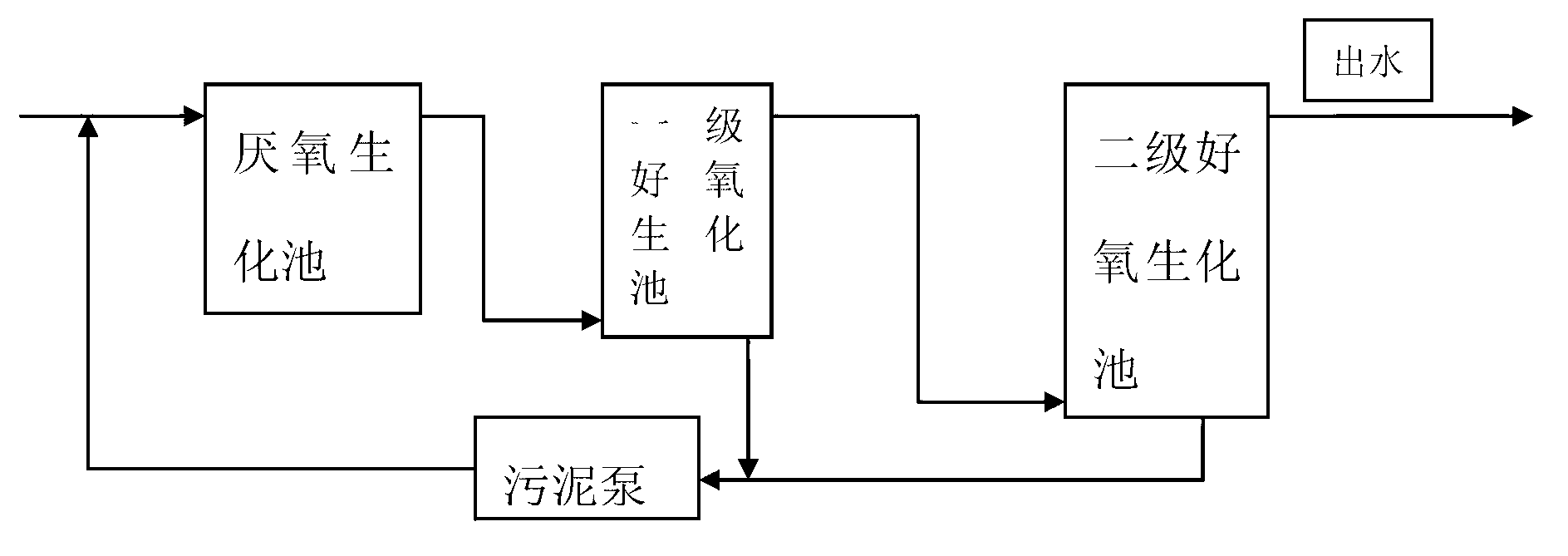Method for degrading ammonia nitrogen in high-salinity sewage by microbes
A technology for microbial degradation and high-salt sewage, which is applied in the field of microbial degradation of ammonia nitrogen in high-salt sewage, can solve the problems of reducing ammonia nitrogen and organic matter removal rate, increasing the concentration of suspended solids in effluent, and reducing the number and species of microorganisms. The effect of increasing the nitrification rate and shortening the nitrification time
- Summary
- Abstract
- Description
- Claims
- Application Information
AI Technical Summary
Problems solved by technology
Method used
Image
Examples
Embodiment 1
[0018] Example 1: Biodegradation of ammonia nitrogen in high-salt wastewater from petroleum refineries
[0019] Establishment of ammonia nitrogen treatment process for biodegradable high-salt wastewater
[0020] The influent water is wastewater from a petroleum refinery, and the inoculated microorganisms in the anaerobic and aerobic biological reaction tanks are activated sludge, with a concentration of 5g / L, and the ratio of activated sludge and high-efficiency nitrifying bacteria in the secondary aerobic oxidation tank is 1:1.
[0021] The water of the domesticated sludge is the effluent of petroleum refinery, and the source of sludge is the sludge at the bottom of the sewage tank of the refinery, the sludge of the biochemical treatment tank of the sewage treatment station, and the mixed sewage of high-efficiency salt-tolerant bacterial strains (mainly Flavobacteriu Staphylococcus, etc.) mud. Sludge acclimatization is carried out intermittently, and the raw water is dilute...
Embodiment 2
[0025] Embodiment 2: printing and dyeing wastewater treatment
[0026] Take the wastewater from a printing and dyeing factory, the salinity is 5-6g / L, the ammonia nitrogen is 240mg / L, the COD 5 It is 1500mg / L. After diluting by 4 times, artificially supplement ammonia nitrogen to 200mg / L as influent.
[0027] Sludge domestication, screening of efficient nitrifying bacteria, and control of conditions are the same as in Example 1.
[0028] After stable operation, the residence time of the anaerobic treatment tank is 5 hours, the residence time of the primary aerobic tank is 3 hours, the residence time of the secondary aerobic tank is 3 hours, the effluent ammonia nitrogen is less than 10mg / L, and the COD 5 <50mg / L
Embodiment 3
[0029] Embodiment 3: Treatment of reverse osmosis effluent
[0030] The mixed wastewater of reverse osmosis effluent and membrane washing wastewater in a certain workshop. The conductance is 22.3ms / cm, COD 5 is 400mg / L, and the concentration of ammonia nitrogen is 230mg / L.
[0031] Sludge domestication, screening of efficient nitrifying bacteria, and control of conditions are the same as in Example 1.
[0032] After stable operation, the residence time of the anaerobic treatment tank is 3 hours, the residence time of the primary aerobic tank is 3 hours, the residence time of the secondary aerobic tank is 2.5 hours, the effluent ammonia nitrogen is less than 5mg / L, and the COD 5 <30mg / L.
PUM
 Login to View More
Login to View More Abstract
Description
Claims
Application Information
 Login to View More
Login to View More - R&D
- Intellectual Property
- Life Sciences
- Materials
- Tech Scout
- Unparalleled Data Quality
- Higher Quality Content
- 60% Fewer Hallucinations
Browse by: Latest US Patents, China's latest patents, Technical Efficacy Thesaurus, Application Domain, Technology Topic, Popular Technical Reports.
© 2025 PatSnap. All rights reserved.Legal|Privacy policy|Modern Slavery Act Transparency Statement|Sitemap|About US| Contact US: help@patsnap.com

